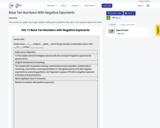
This activity is a great way to get students talking about patterns they see in the negative exponents chart.
- Subject:
- Number and Number Sense
- Material Type:
- Activity/Lab
- Author:
- Lana Reed
- Date Added:
- 05/02/2021

This activity is a great way to get students talking about patterns they see in the negative exponents chart.

Each student will step up to bat. The “pitcher” will toss the ball, pitch, and give a student a letter, letter sound, or their name. That student will then write the letter on the dry erase board. Next the student will RUN to their base. If they get the letter or letter sound correct they are safe, If they get the Letter or sound incorrect, that is STRIKE 1, students get three chances, after 3 wrong answers they are out. Students will score points when students cross home plate.

Normal Distribution Mathematics Instructional Plans (MIPs) help teachers align instruction with the 2016 Mathematics Standards of Learning (SOL) by providing examples of how the knowledge, skills and processes found in the SOL and curriculum framework can be presented to students in the classroom.

Students will understand and explain the difference between a model and a simulation. Modeling means creating a physical replica or equations of a situation or activity. A simulation is a virtual representation of a process that reflects how a real physical situation would most likely happen. In Mathematics 8, students explore 3D models given a 2 dimensional perspective from the front/back, sides, and top. This will be an introduction to explore modeling 3D figures with a hands-on approach.

This short reading about the springtime has varying images that are downloadable. One is a simple reading. Another is the same reading with short questions that follow. Another is a fill in the blank story based on the picture.

Students will build upon knowledge of hardware and software used in a computer system to determine what is used for input, output and both.

This is an activity to use with students as they are learning how to read a map and decipher continents and oceans. This activity is intended for high school students and can also be used as a check for understanding.

This is an activity to use with students as they are learning how to read a map and decipher continents and oceans. This activity is intended for high school students and can also be used as a check for understanding.

This is an activity to use with students as they are learning how to read a map and decipher continents and oceans. This activity is intended for high school students and can also be used as a check for understanding.

This lesson has students complete a basketball activity and then use the data from the activity to create a scatterplot. Once they create their scatterplot they determine correlation and draw a line of best fit.

Links to 20-21 Return to School Plan and documents/information for students and parents.

Learn about bats -- a diverse group of flying mammals that humans often associate with folklore, legends, ghost stories, and scary tales. But we have more in common with bats than we think -- these tiny mammals are socially intelligent and can have a rich social structure and means of communication with each other. Bats are not only fascinating, but they are also quite beneficial to our environment and play an important role in the habitats we share with them. These animals are in need of our help now more than ever as they face population declines and serious problems, most of which originate from humans.

Look inside a battery to see how it works. Select the battery voltage and little stick figures move charges from one end of the battery to the other. A voltmeter tells you the resulting battery voltage.

This video is part of the Learn and Grow with WHRO TV series. Watch Brandon Thompson teach about being brave and making predictions.

To make the most of the Internet, kids need to be prepared to make smart decisions. Be Internet Awesome empowers kids with tools and education to confidently and safely explore, grow, and play online.

This lesson aims to teach students how to use computing devices and networks responsibly and ethically and to develop critical thinking skills to identify social and ethical issues rEnglishted to technology.

This a rhyming game wiith lots of movement.

This a remix of Bean-Counter Evolution found at https://goopenva.org/courses/bean-counter-evolution, suggesting some modifications and extensions that could be used.

The students will practice making algorithms emphasizing beginning, middle, and end while investigating the life cycle of a bean plant. They will begin by watching a video of a bean plant growing and listening to a read aloud about a plant growing. After this, they will discuss the beginning, middle, and end of the bean plant’s life cycle. At the end of the lesson, the students will each create an algorithm of how the bean plant grows by drawing the beginning, middle, and end of the bean plant’s life cycle.

Recognizing and describing part-whole relationships for numbers up to 10Mathematics Instructional Plans (MIPs) help teachers align instruction with the 2016 Mathematics Standards of Learning (SOL) by providing examples of how the knowledge, skills and processes found in the SOL and curriculum framework can be presented to students in the classroom.